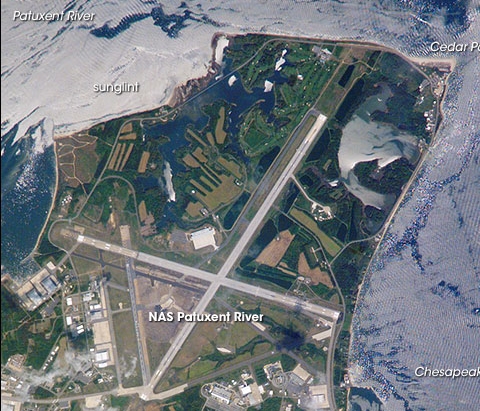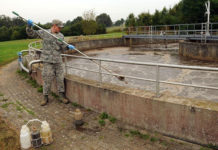
Materials are being temporarily held in a MetCom holding tank; ultimate fate is unknown
The Patuxent River Naval Air Station, on the Chesapeake Bay in St. Mary’s County, Maryland, announced in the last week of May that toxic aqueous film-forming foam (AFFF), was released on base after an accidental discharge from a hangar’s fire suppression system.
2,500 gallons were said to be sent down the drain.
AFFF contains per-and poly fluoroalkyl substances (PFAS). The toxic foam entered a St. Mary’s County Metropolitan (MetCom) drain in the hangar and travelled to a MetCom holding tank during the May 16th incident.
The foam release was “cleaned up by environmental crews” and is held at a MetCom wastewater treatment plant, a Navy spokesman told Southern Maryland News.
These chemicals cannot simply be “cleaned up” as they are “forever chemicals,” which are a threat to human health in the smallest amounts. They do not break down and they bioaccumulate in seafood and humans.

The Navy reported, “Naval Air Station Patuxent River, with community partner St. Mary’s County Metropolitan Commission (MetCom), mitigated the release of Aqueous Film Forming Foam (AFFF) after a system reset caused a discharge within an installation aircraft hangar May 16.”
George Erichsen, METCOM’s Executive Director, said the release was estimated at 2,500 gallons. “Our staff noticed foam in the equalization basin that we have dedicated to the base (not in the treatment works). They use a defoaming agent to dissipate the foam.”
In a recent interview with the author, Erichsen further stated that “all of the carcinogens were pumped two miles into the center of the bay.”
In short, the PFAS wasn’t treated, it was just sent into the rivers.
The 2,500-gallon release of toxic foam from a military hangar is believed to be one of the largest in many years.
Few understand the potential threat to public health while the base’s public information office, keeping to a prepared script, produced a press release that makes the Navy look like they have done something admirable.
There are several points that must be clarified in the Navy’s press statement regarding the release of the PFAS-laden foam. The Navy says it “mitigated the release” of AFFF. The notion is absurd. How, exactly does the Naval Command expect to save the environment from these 2,500 gallons of highly concentrated toxic and lethal chemicals that are now, presumably, in a MetCom holding tank? If the liquid enters MetCom’s system, as it has many times in the past, it will be discharged into Big Pine Run and will flow into the Bay, a mile away. American wastewater treatment plants do not treat PFAS before it is dumped into the rivers.
What does the Navy plan to do with these materials? They can no longer be allowed to saturate the ground. They cannot be incinerated as they have been in the past. The people of St. Mary’s County must be asking the Navy, “What’s the plan for these chemicals?”
The Navy says the newer forms of AFFF firefighting foam, like the foam recently released on base, does not contain detectable levels of PFOA or PFOS, two notoriously deadly varieties of the foams. Actually, the Navy has replaced the old toxic firefighting foam with a new variety of toxic firefighting foam.
The Navy says the “cause of the AFFF discharge is under investigation.”
The Navy always makes it seem like these releases are novel situations. They know what happened and they know it will likely happen again, and they have shown that they do not care about the environment, although they are worried about too many people reading these lines.
Environmental activists on March 3, 2020, protested contamination of local waterways by the Navy.
History of AFFF Releases at Pax River
There have been 17 separate locations on base where AFFF was allowed to leach into the ground or it was sent down the sewer drain to MetCom. The spills are detailed in a 2018 report, “Final Preliminary Assessment Report for Potential Releases of Per and Poly Fluoroalkyl Substances,” 07/01/18. See the CH2M Hill Report.
Multiple releases of AFFF in 2002, 2005, and 2010 have occurred from the suppression system in Joint Strike Fighter Hangar 2133. In at least one incident (date unknown) the entire system inadvertently went off.
The Navy has still not revealed the exact quantities of AFFF concentrate and foam that were released, although the total is likely to be in the many thousands of gallons. These suppression sprinkler systems are capable of covering massive hangars with 10 feet of foam in a few minutes.
During the 2010 event, an unknown amount of AFFF foam entered the sanitary sewer leading to the MetCom facility.

In 2010 MetCom had to shut off sewage flow and deal with reactivated AFFF in all the aeration basins. MetCom “dealt with” the materials by releasing them into the environment as it does routinely. After all, these are not regulated materials. The EPA seems not to believe that the Navy has done anything wrong, so the Navy continues to act in a reckless fashion.
Building 1669 (500 gallons) and Hangar 2905 (150 gallons) have also released AFFF into MetCom’s sanitary sewer.
Another of the nation’s largest releases also occurred at Pax River. In April 2015, contents of a 2,200-gallon tank of AFFF was released due to mechanical failure of the suppression system from Hangar 110, although it eventually drained into the Chesapeake Bay rather than arriving at the same destination through the local wastewater treatment plant.
A study by researchers at the University of Maryland examined the folly of AFFF use in commercial hangars. The report collected information on AFFF releases from 174 civilian hangars throughout the U.S. from 2004 to 2019.
There were 37 incidents where the foam system discharged in response to a fire and 137 incidents where there was an accidental foam discharge. Over the last 16 years, only one of the 174 incidents involved a pooled spill fire, and the foam suppression system did not discharge in this incident. The most frequent cause noted for the accidental discharge was a “suppression system failure.”
While some fires do occur in aircraft hangars, they involve ordinary combustibles or occur in spaces adjacent to the hangar bay.
Fire sensors have been faulty and manual release switches may be vulnerable to corrosion. Sometimes human error triggers the foam releases. Sometimes frozen pipes may burst, triggering the suppression system.
The foams have been released because sensitive monitors have picked up the smoke from welders or barbecues. In the civilian sector, systems may not be frequently maintained and may suffer from poor maintenance. The Navy does not publicize these sorts of records, so we are left in the dark. Experts say many systems are destined for failure. It is not a matter of if they will go off, but when.
We are engineering against a largely non-existent threat while public health is endangered. Perhaps most ironic is that much of the world has already switched to using environmentally friendly fluorine-free foams.

A more in-depth version of this article is available here.
CovertAction Magazine is made possible by subscriptions, orders and donations from readers like you.
Blow the Whistle on U.S. Imperialism
Click the whistle and donate
When you donate to CovertAction Magazine, you are supporting investigative journalism. Your contributions go directly to supporting the development, production, editing, and dissemination of the Magazine.
CovertAction Magazine does not receive corporate or government sponsorship. Yet, we hold a steadfast commitment to providing compensation for writers, editorial and technical support. Your support helps facilitate this compensation as well as increase the caliber of this work.
Please make a donation by clicking on the donate logo above and enter the amount and your credit or debit card information.
CovertAction Institute, Inc. (CAI) is a 501(c)(3) non-profit organization and your gift is tax-deductible for federal income purposes. CAI’s tax-exempt ID number is 87-2461683.
We sincerely thank you for your support.
Disclaimer: The contents of this article are the sole responsibility of the author(s). CovertAction Institute, Inc. (CAI), including its Board of Directors (BD), Editorial Board (EB), Advisory Board (AB), staff, volunteers and its projects (including CovertAction Magazine) are not responsible for any inaccurate or incorrect statement in this article. This article also does not necessarily represent the views the BD, the EB, the AB, staff, volunteers, or any members of its projects.
Differing viewpoints: CAM publishes articles with differing viewpoints in an effort to nurture vibrant debate and thoughtful critical analysis. Feel free to comment on the articles in the comment section and/or send your letters to the Editors, which we will publish in the Letters column.
Copyrighted Material: This web site may contain copyrighted material the use of which has not always been specifically authorized by the copyright owner. As a not-for-profit charitable organization incorporated in the State of New York, we are making such material available in an effort to advance the understanding of humanity’s problems and hopefully to help find solutions for those problems. We believe this constitutes a ‘fair use’ of any such copyrighted material as provided for in section 107 of the US Copyright Law. You can read more about ‘fair use’ and US Copyright Law at the Legal Information Institute of Cornell Law School.
Republishing: CovertAction Magazine (CAM) grants permission to cross-post CAM articles on not-for-profit community internet sites as long as the source is acknowledged together with a hyperlink to the original CovertAction Magazine article. Also, kindly let us know at info@CovertActionMagazine.com. For publication of CAM articles in print or other forms including commercial internet sites, contact: info@CovertActionMagazine.com.
By using this site, you agree to these terms above.
About the Author

Pat Elder is a peace and environmental activist who has run for Congress on the Green Party ticket in Southern Maryland.
He can be reached at: pelder@militarypoisons.org.








